radiator cap Acura TSX 2007 Owner's Manual
[x] Cancel search | Manufacturer: ACURA, Model Year: 2007, Model line: TSX, Model: Acura TSX 2007Pages: 379, PDF Size: 5.45 MB
Page 59 of 379
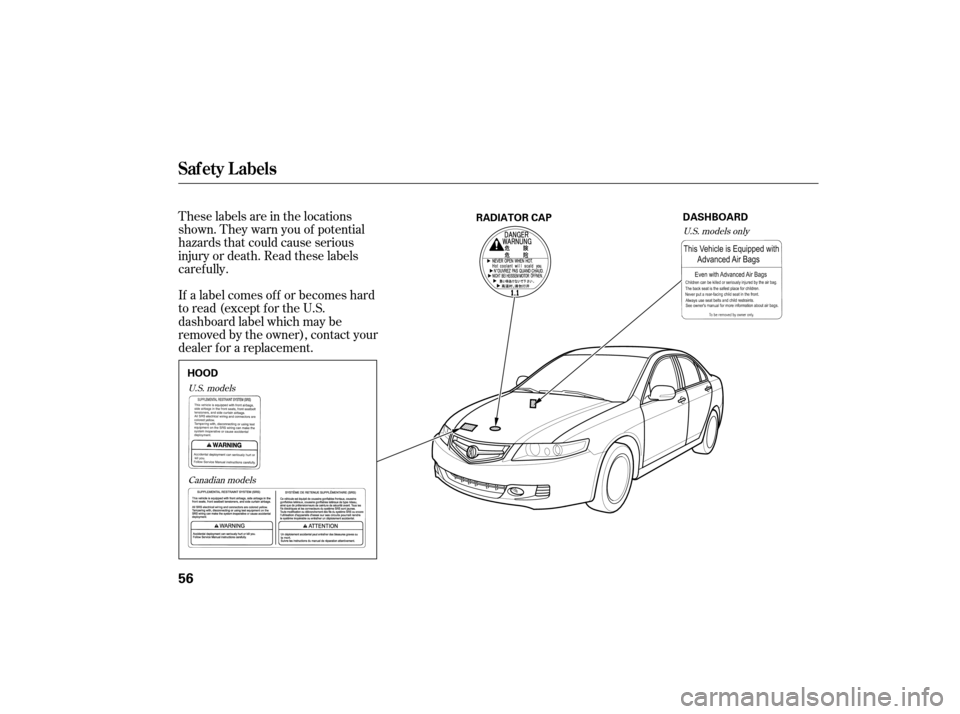
These labels are in the locations
shown. They warn you of potential
hazards that could cause serious
injury or death. Read these labels
caref ully.
If a label comes of f or becomes hard
to read (except for the U.S.
dashboard label which may be
removed by the owner), contact your
dealer f or a replacement.
U.S. modelsCanadian models U.S. models only
Saf ety L abels
56
DASHBOARD
HOOD RADIATOR CAP
Page 289 of 379
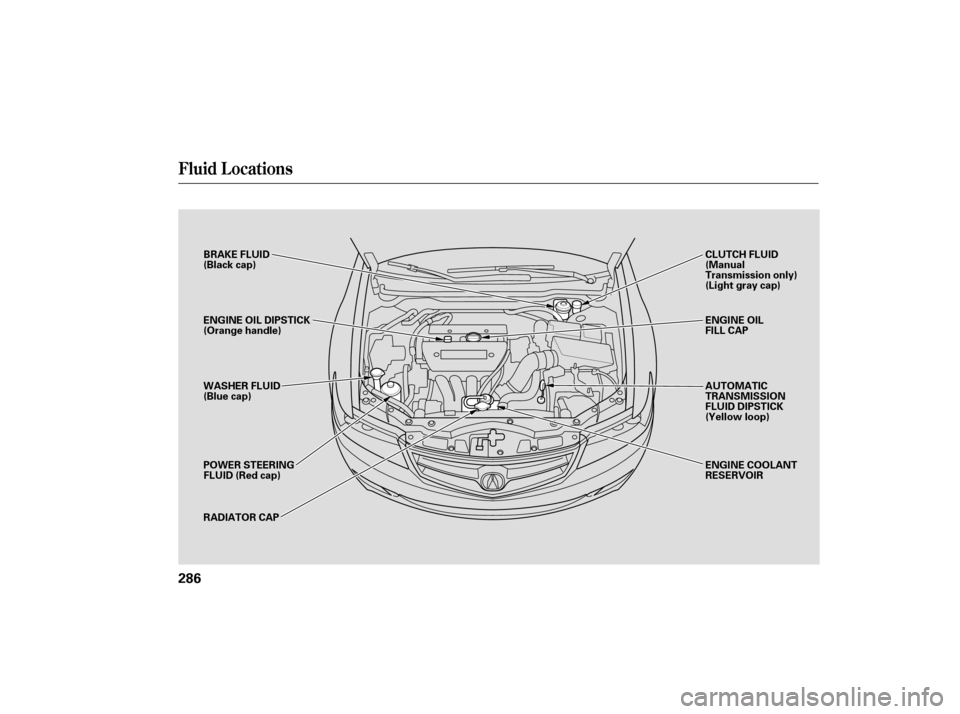
Fluid Locations
286
RADIATOR CAPCLUTCH FLUID
(Manual
Transmission only)
(Light gray cap)
AUTOMATIC
TRANSMISSION
FLUID DIPSTICK
(Yellow loop) ENGINE OIL
FILL CAP
BRAKE FLUID
(Black cap)
ENGINE OIL DIPSTICK
(Orange handle)
WASHER FLUID
(Blue cap)
POWER STEERING
FLUID (Red cap)
ENGINE COOLANT
RESERVOIR
Page 294 of 379
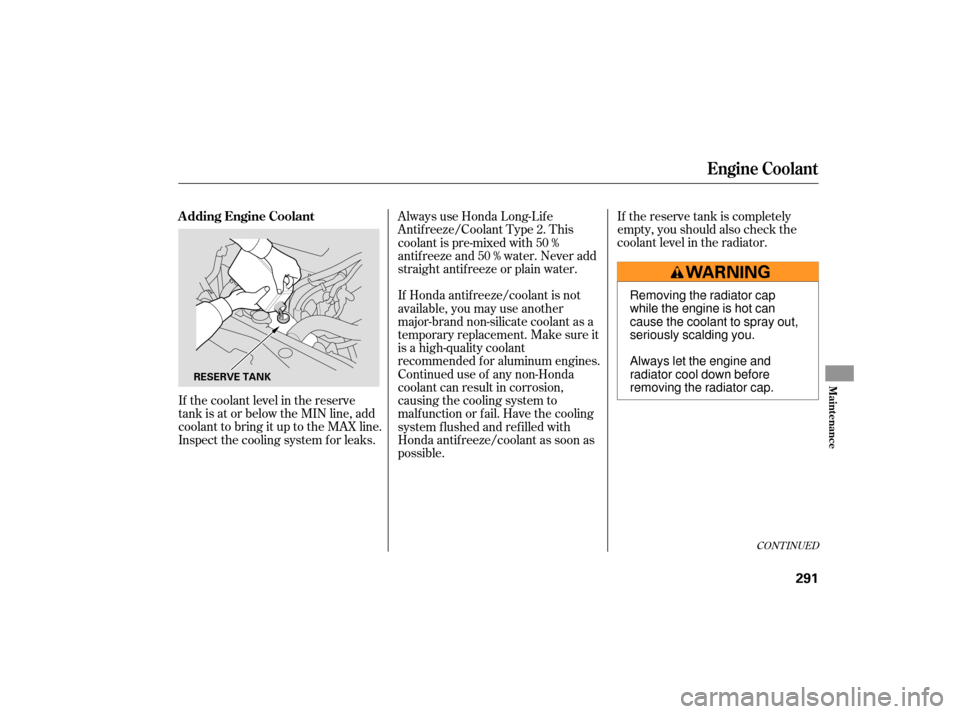
CONT INUED
If the reserve tank is completely
empty, you should also check the
coolant level in the radiator.
If the coolant level in the reserve
tank is at or below the MIN line, add
coolant to bring it up to the MAX line.
Inspect the cooling system f or leaks. If Honda antif reeze/coolant is not
available, you may use another
major-brand non-silicate coolant as a
temporaryreplacement.Makesureit
is a high-quality coolant
recommended f or aluminum engines.
Continued use of any non-Honda
coolant can result in corrosion,
causing the cooling system to
malf unction or f ail. Have the cooling
system f lushed and ref illed with
Honda antif reeze/coolant as soon as
possible. Always use Honda Long-Lif e
Antif reeze/Coolant Type 2. This
coolant is pre-mixed with 50 %
antif reeze and 50 % water. Never add
straight antif reeze or plain water.
A dding Engine Coolant
Engine Coolant
Maint enance
291
RESERVE TANK
Removing the radiator cap
while the engine is hot can
cause the coolant to spray out,
seriously scalding you.
Always let the engine and
radiator cool down before
removing the radiator cap.
Page 295 of 379
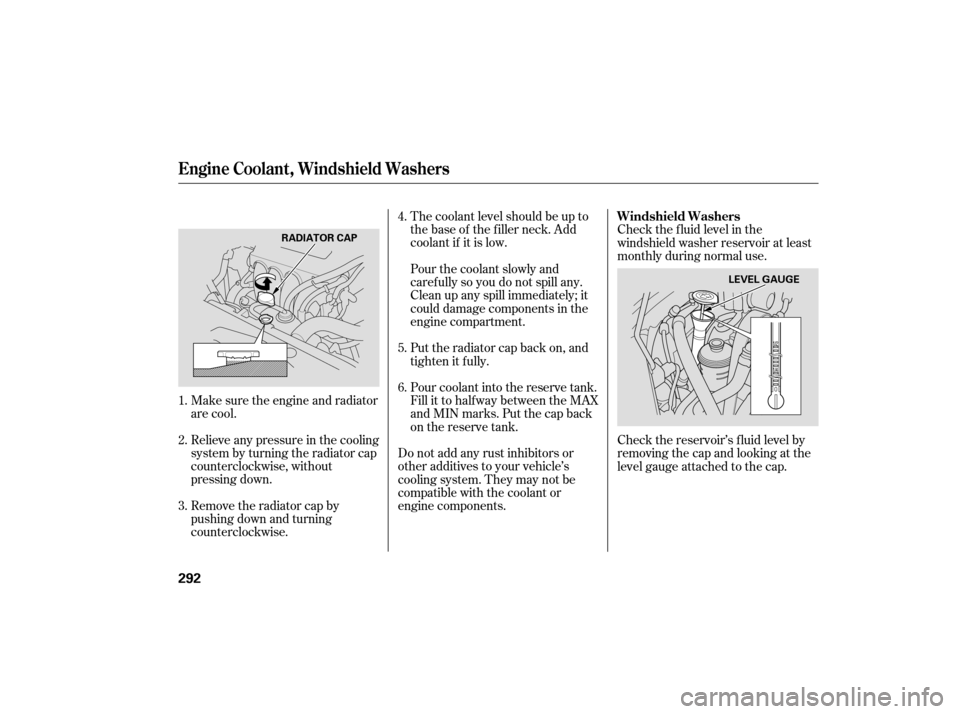
Make sure the engine and radiator
are cool.
Remove the radiator cap by
pushing down and turning
counterclockwise. Relieve any pressure in the cooling
system by turning the radiator cap
counterclockwise, without
pressing down.The coolant level should be up to
the base of the f iller neck. Add
coolant if it is low.
Pourthecoolantslowlyand
caref ully so you do not spill any.
Clean up any spill immediately; it
could damage components in the
engine compartment.
Put the radiator cap back on, and
tighten it fully.
Pour coolant into the reserve tank.
Fill it to half way between the MAX
and MIN marks. Put the cap back
on the reserve tank.
Do not add any rust inhibitors or
other additives to your vehicle’s
cooling system. They may not be
compatible with the coolant or
engine components. Check the f luid level in the
windshield washer reservoir at least
monthly during normal use.
Check the reservoir’s f luid level by
removing the cap and looking at the
level gauge attached to the cap.
4.
1.
2.
3. 5.
6.
Engine Coolant, Windshield Washers
Windshield Washers
292
RADIATOR CAP
LEVEL GAUGE
Page 296 of 379
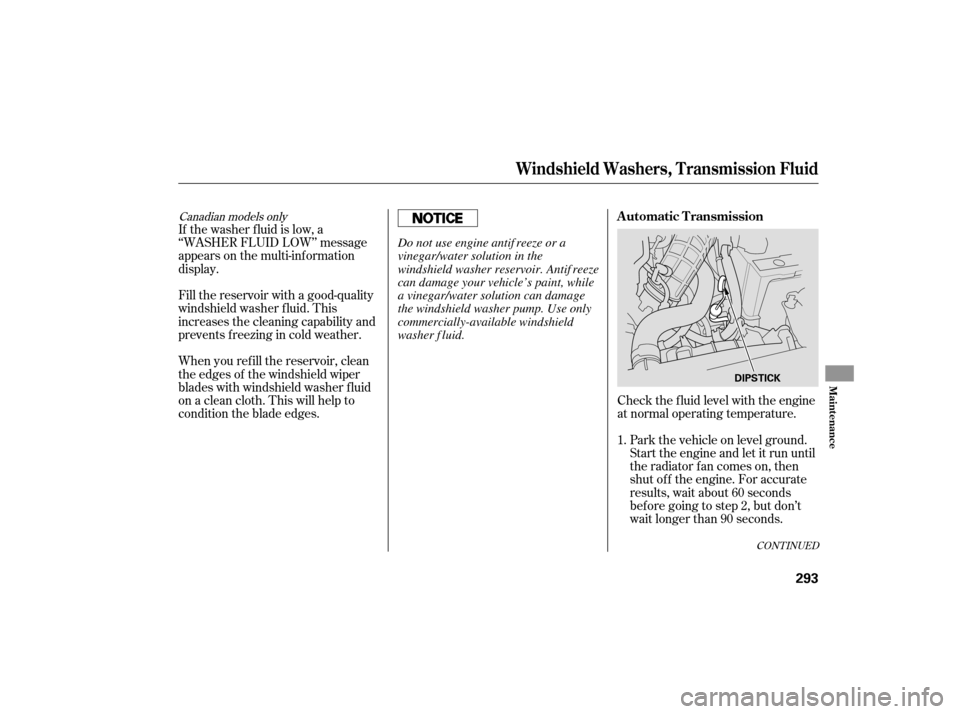
Canadian models only
If the washer f luid is low, a
‘‘WASHER FLUID LOW’’ message
appears on the multi-inf ormation
display.
Fill the reservoir with a good-quality
windshield washer f luid. This
increases the cleaning capability and
prevents f reezing in cold weather.
When you ref ill the reservoir, clean
the edges of the windshield wiper
blades with windshield washer f luid
on a clean cloth. This will help to
condition the blade edges.Check the f luid level with the engine
at normal operating temperature.
Park the vehicle on level ground.
Start the engine and let it run until
the radiator fan comes on, then
shut of f the engine. For accurate
results, wait about 60 seconds
bef ore going to step 2, but don’t
wait longer than 90 seconds.
1.
CONT INUED
Automatic Transmission
Windshield Washers, T ransmission Fluid
Maint enance
293
DIPSTICK
Do not use engine antif reeze or a
vinegar/water solution in the
windshield washer reservoir. Antif reeze
can damage your vehicle’s paint, while
a vinegar/water solution can damage
the windshield washer pump. Use only
commercially-available windshield
washer f luid.
Page 333 of 379
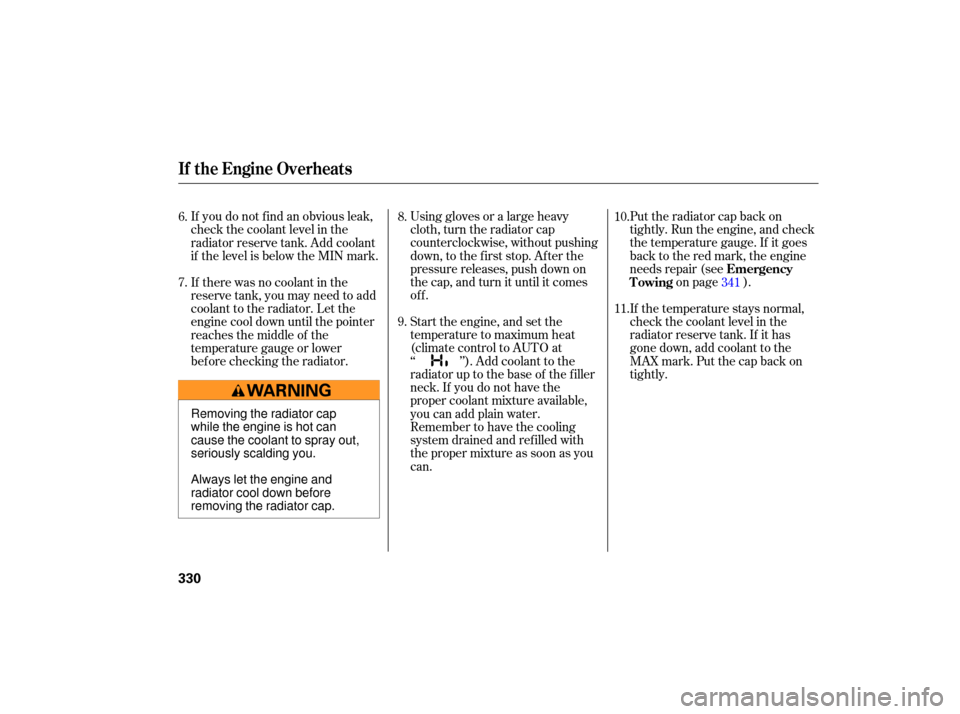
Using gloves or a large heavy
cloth, turn the radiator cap
counterclockwise, without pushing
down, to the first stop. After the
pressure releases, push down on
the cap, and turn it until it comes
off. Put
the radiator cap back on
tightly. Run the engine, and check
the temperature gauge. If it goes
back to the red mark, the engine
needs repair (see on page ).
If the temperature stays normal,
check the coolant level in the
radiator reserve tank. If it has
gone down, add coolant to the
MAX mark. Put the cap back on
tightly.
If you do not f ind an obvious leak,
check the coolant level in the
radiator reserve tank. Add coolant
if the level is below the MIN mark.
Start the engine, and set the
temperature to maximum heat
(climate control to AUTO at
‘‘ ’’). Add coolant to the
radiator up to the base of the f iller
neck. If you do not have the
proper coolant mixture available,
you can add plain water.
Remember to have the cooling
system drained and ref illed with
the proper mixture as soon as you
can.
If there was no coolant in the
reserve tank, you may need to add
coolant to the radiator. Let the
engine cool down until the pointer
reaches the middle of the
temperature gauge or lower
bef ore checking the radiator.
7. 6.
8.
9. 10.
11.
341
Emergency
Towing
If theEngineOverheats
330
Removing the radiator cap
while the engine is hot can
cause the coolant to spray out,
seriously scalding you.
Always let the engine and
radiator cool down before
removing the radiator cap.